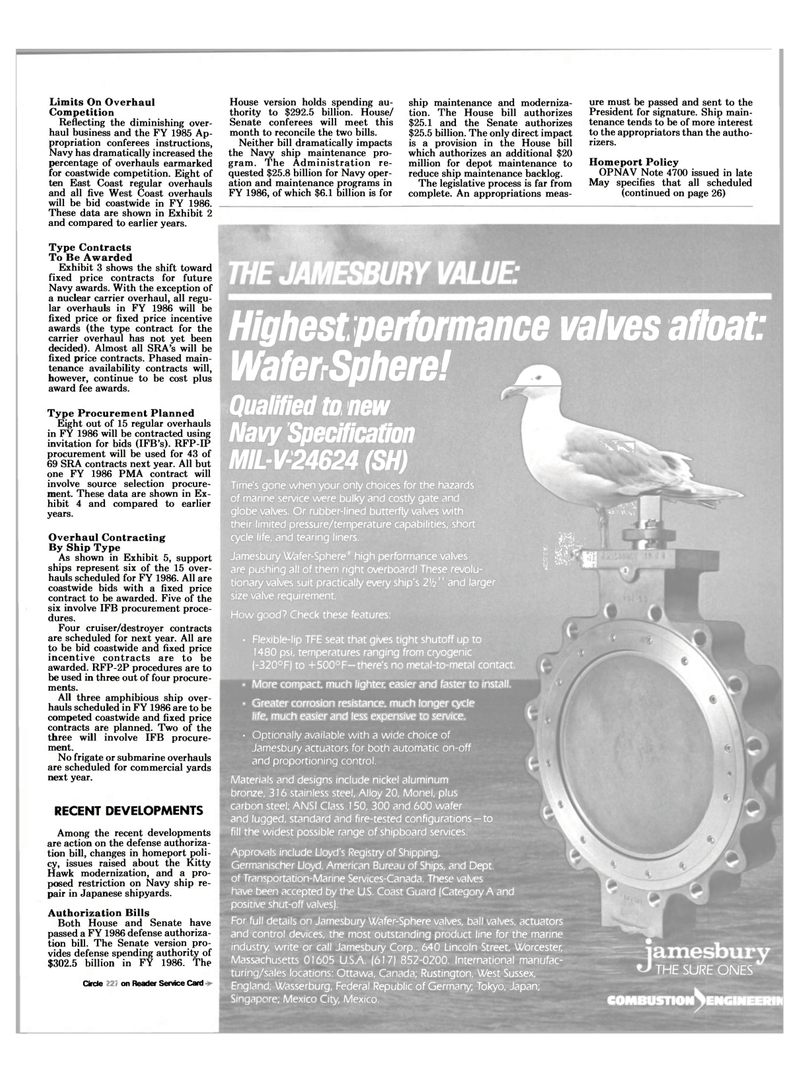
Page 23: of Maritime Reporter Magazine (July 15, 1985)
Read this page in Pdf, Flash or Html5 edition of July 15, 1985 Maritime Reporter Magazine
Limits On Overhaul
Competition
Reflecting the diminishing over- haul business and the FY 1985 Ap- propriation conferees instructions,
Navy has dramatically increased the percentage of overhauls earmarked for coastwide competition. Eight of ten East Coast regular overhauls and all five West Coast overhauls will be bid coastwide in FY 1986.
These data are shown in Exhibit 2 and compared to earlier years.
Type Contracts
To Be Awarded
Exhibit 3 shows the shift toward fixed price contracts for future
Navy awards. With the exception of a nuclear carrier overhaul, all regu- lar overhauls in FY 1986 will be fixed price or fixed price incentive awards (the type contract for the carrier overhaul has not yet been decided). Almost all SRA's will be fixed price contracts. Phased main- tenance availability contracts will, however, continue to be cost plus award fee awards.
Type Procurement Planned
Eight out of 15 regular overhauls in FY 1986 will be contracted using invitation for bids (IFB's). RFP-IP procurement will be used for 43 of 69 SRA contracts next year. All but one FY 1986 PMA contract will involve source selection procure- ment. These data are shown in Ex- hibit 4 and compared to earlier years.
Overhaul Contracting
By Ship Type
As shown in Exhibit 5, support ships represent six of the 15 over- hauls scheduled for FY 1986. All are coastwide bids with a fixed price contract to be awarded. Five of the six involve IFB procurement proce- dures.
Four cruiser/destroyer contracts are scheduled for next year. All are to be bid coastwide and fixed price incentive contracts are to be awarded. RFP-2P procedures are to be used in three out of four procure- ments.
All three amphibious ship over- hauls scheduled in FY 1986 are to be competed coastwide and fixed price contracts are planned. Two of the three will involve IFB procure- ment.
No frigate or submarine overhauls are scheduled for commercial yards next year.
RECENT DEVELOPMENTS
Among the recent developments are action on the defense authoriza- tion bill, changes in homeport poli- cy, issues raised about the Kitty
Hawk modernization, and a pro- posed restriction on Navy ship re- pair in Japanese shipyards.
Authorization Bills
Both House and Senate have passed a FY 1986 defense authoriza- tion bill. The Senate version pro- vides defense spending authority of $302.5 billion in FY 1986. The
Circle 313 on Reader Service Card
House version holds spending au- thority to $292.5 billion. House/
Senate conferees will meet this month to reconcile the two bills.
Neither bill dramatically impacts the Navy ship maintenance pro- gram. The Administration re- quested $25.8 billion for Navy oper- ation and maintenance programs in
FY 1986, of which $6.1 billion is for ship maintenance and moderniza- tion. The House bill authorizes $25.1 and the Senate authorizes $25.5 billion. The only direct impact is a provision in the House bill which authorizes an additional $20 million for depot maintenance to reduce ship maintenance backlog.
The legislative process is far from complete. An appropriations meas- ure must be passed and sent to the
President for signature. Ship main- tenance tends to be of more interest to the appropriators than the autho- rizes.
Homeport Policy
OPNAV Note 4700 issued in late
May specifies that all scheduled (continued on page 26)
Highest performance valves afloat: Wafer-Sphere! a
Qualified to new
Navy Specification
MIL-V-24624 (SH)
Time's gone when your only choices for the hazards of marine service were bulky and costly gate and globe valves. Or rubber-lined butterfly valves with their limited pressure/temperature capabilities, short cycle life, and tearing liners.
Jamesbury Wafer-Sphere"5 high performance valves are pushing all of them right overboard! These revolu- tionary valves suit practically every ship's 2'/2'' and larger size valve requirement.
How good? Check these features: • Flexible-lip TFE seat that gives tight shutoff up to 1480 psi, temperatures ranging from cryogenic (-320°F) to + 500°F-there's no metal-to-metal contact. • More compact, much lighter, easier and faster to install. • Greater corrosion resistance, much longer cycle life, much easier and less expensive to seivice. wy^a torn £• WV^Vr ') SF-J 11 ^ s
THE SURE ONES • Optionally available with a wide choice of
Jamesbury actuators for both automatic on-off and proportioning control.
Materials and designs include nickel aluminum bronze, 316 stainless steel. Alloy 20, Monel, plus carbon steel; ANSI Class 150, 300 and 600 wafer and lugged, standard and fire-tested configurations—to fill the widest possible range of shipboard services.
Approvals include Lloyd's Registry of Shipping,
Germanischer Lloyd, American Bureau of Ships, and Dept. of Transportation-Marine Services-Canada. These valves have been accepted by the U.S. Coast Guard (Category A and positive shut-off valves).
For full details on Jamesbury Wafer-Sphere valves, ball valves, actuators and control devices, the most outstanding product line for the marine industry, write or call Jamesbury Corp., 640 Lincoln Street, Worcester,
Massachusetts 01605 U.SA (617) 852-0200. International manufac- turing/sales locations: Ottawa, Canada; Rustington, West Sussex,
England; Wasserburg, Federal Republic of Germany; Tokyo, Japan;
Singapore; Mexico City, Mexico.

 22
22

 24
24
